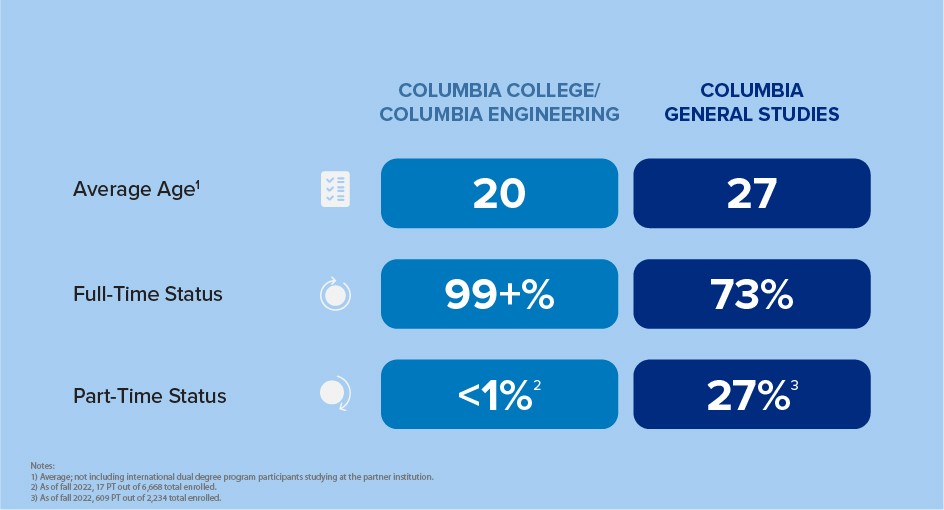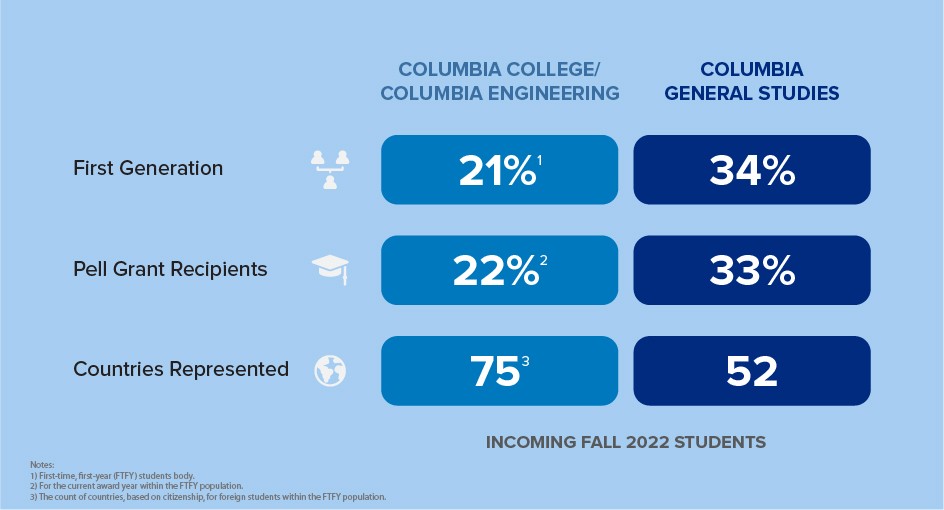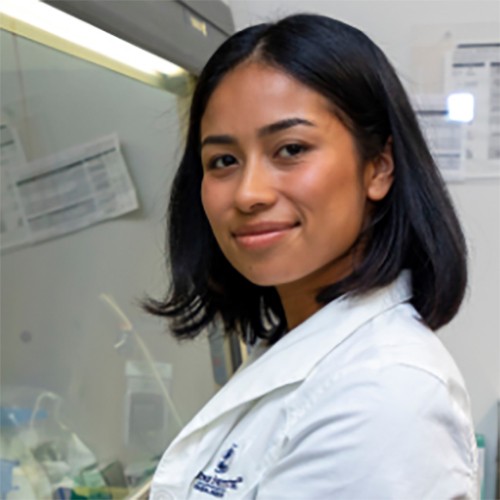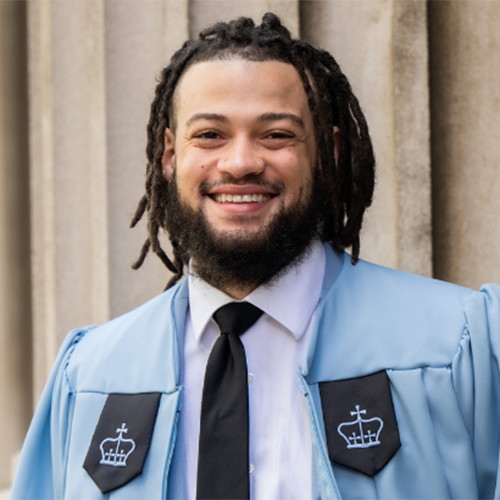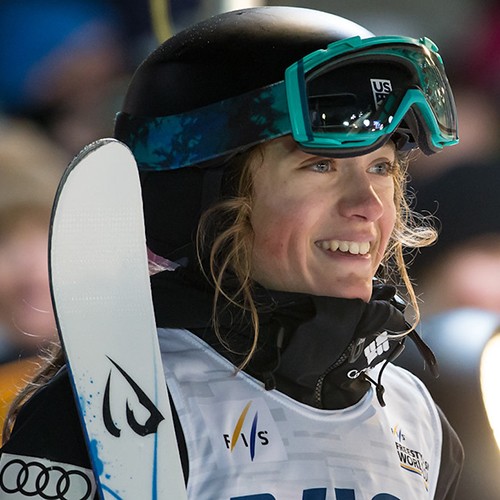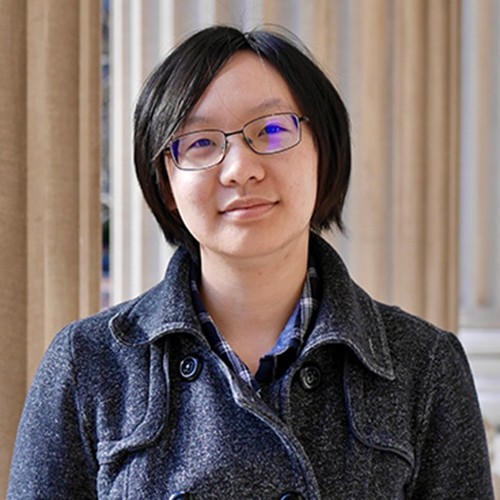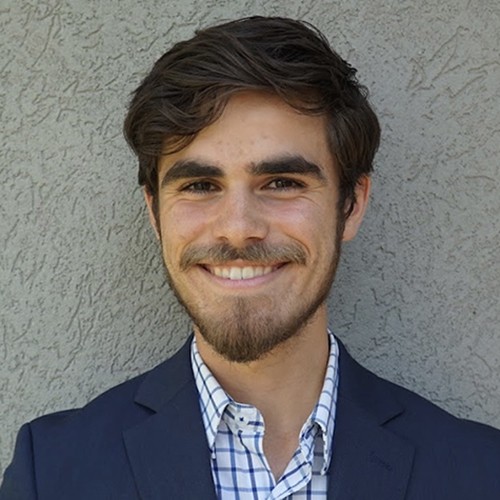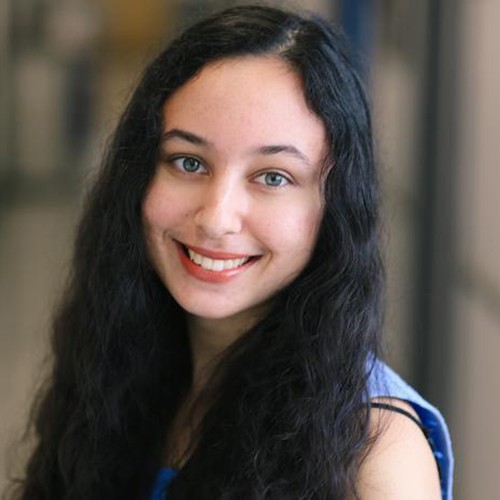The CDS and the Undergraduate Experience at Columbia
The Common Data Set (CDS) Initiative is a collaborative effort among data providers in the higher education community. The goal of this collaboration is to improve the quality and accuracy of information available to all involved in a student’s transition into higher education.
We are providing two Common Data Sets to represent our unique undergraduate populations fully. We will post these two documents, along with additional facts and analysis, every year to support prospective students and their families as they consider college choices.
Data is also publicly available through a range of sources, including the College Scorecard and College Navigator. The best source for historical data about our undergraduates is the Integrated Postsecondary Education Data System (IPEDS—Columbia is identified as UnitID 190150). All three are run by the U.S. Department of Education. Please note that federal data combines all undergraduates at Columbia University, including Columbia College, Columbia Engineering, and Columbia General Studies.
What Makes Columbia Unique?
At the undergraduate level, Columbia University comprises three schools: Columbia College, Fu Foundation School of Engineering and Applied Science, and Columbia University School of General Studies. While the vast majority of Columbia College and Columbia Engineering students enter Columbia directly from high school, Columbia General Studies (GS) is the only fully integrated undergraduate program in the Ivy League dedicated to serving nontraditional students, including those who have taken a break in their studies, those transferring from community college, and those in dual and joint degree programs.
The Core Curriculum represents the common thread that connects Columbia undergraduates, regardless of the paths that lead them to the university.
The most distinctive feature of the Columbia undergraduate experience is its celebrated 100-year-old Core Curriculum, which introduces students to influential books and ideas in literature, philosophy, science, history, art, and music. Most Core classes are small and discussion-based, part of the university’s commitment to highly interactive engagement among undergraduate students and faculty and designed to support a diversity of perspectives in the classroom. For undergraduate students at all three schools, Core seminars provide a setting that encourages active engagement and discussion and the development of strong faculty relationships.
The Core’s central purpose is to teach students how to think critically, challenge assumptions, and have open and probing discussions about complex issues. Core classes push students to grapple with profound questions about the human experience that have engaged the brightest minds throughout recorded history. Requirements vary somewhat among the three undergraduate schools, but the Core represents the common thread that connects all Columbia undergraduates, regardless of the paths that lead them to the university.
Incoming Columbia College and Columbia Engineering students are primarily first-time or first-year students, meaning they enter Columbia directly from high school and adhere to similar traditional admission requirements. To be eligible to apply for admission to Columbia General Studies, students must have taken a break of a year or more in their educational paths, or they enroll part-time while they balance other demands in their lives, resulting in a student body comprising individuals from a wide array of backgrounds, including professional musicians, dancers, athletes, actors, entrepreneurs, parents, and the largest population of military veterans at any Ivy League university. Columbia General Studies also offers numerous dual and joint degree programs, to which students typically apply directly from high school, and start their studies at partner institutions including Sciences Po in France, Trinity College Dublin, Tel Aviv University, City University of Hong Kong, and List College of the Jewish Theological Seminary, earning two degrees in four years.
Reflecting the city they inhabit, Columbia undergraduates bring a deep and diverse set of backgrounds and experiences to their campus.
All undergraduates, whether enrolled in Columbia College, Columbia Engineering, or Columbia General Studies, are taught by the same professors from the Faculty of Arts and Sciences, as well as faculty from Columbia Engineering, Barnard College, and some Columbia University graduate schools. This fully integrated instruction model means Columbia undergraduates benefit from the broadest possible array of academic peers, with students representing over 100 countries, every state in the U.S., and every imaginable life experience.
The combined population of the three schools, along with the presence of students from Columbia’s affiliate, Barnard College, in classrooms and across many aspects of student life, is intrinsic to the undergraduate experience. We would be a lesser university without the richness our extraordinary range of students brings to classroom life. But beyond the classroom, there are differences in the student profiles between Columbia General Studies and Columbia College/Columbia Engineering, leading us to conclude that posting two Common Data Sets provides the most comprehensive picture of the undergraduate experience.
As an example, students at Columbia College and Columbia Engineering are typically full-time students, whereas a significant number of Columbia General Studies students, about thirty percent, pursue their degrees on a part-time basis.
Alumni Engagement
Engaging with the university’s diverse alumni community is another key facet of the undergraduate experience at Columbia. From the moment students arrive on campus, they are able to meet and interact with graduates across all schools. Alumni, from their first years out of school and for the rest of their lives, have access to a wide array of resources for connection and advancement, including clubs, volunteer groups, in-person and online networking resources, career resources, library access, and events in New York and around the world.
Undergraduates have access to resources through the university-wide Columbia Alumni Association, as well as the alumni associations of Columbia College, Columbia Engineering, and Columbia General Studies.
CCAA:
The Columbia College Alumni Association (CCAA) offers more than 52,000 former students a number of ways to volunteer and stay involved with their peers, campus life, and the wider College community – from intellectual programming, to networking, social engagements, and mentorship opportunities.
Founded on the belief that Columbia College students and alumni benefit from mutual support and engagement, the Odyssey Mentoring Program (OMP) invites current students, recent graduates, and alumni to build a strong, tight-knit community through an array of flexible opportunities to build connections across generations of current and former students.
OMP supports students and alumni in a variety of ways – whether they are seeing answers to quick questions, or in-depth career advice – from quick email exchanges to meetings over coffee, small group sessions, and long-term mentoring relationships.
CEAA:
The Columbia Engineering community of nearly 50,000 undergraduate (~20,000) and graduate (~30,000) alumni extends beyond the campus and New York City, and includes many more parents and friends around the globe. The community comes together in many ways, including through the Columbia Engineering Alumni Association (CEAA), the Columbia Engineering Young Alumni Association (CEYA), and CAA’s many regional and local clubs. Graduates of Columbia Engineering enjoy the full benefits of other members of the Columbia University alumni community. In addition, there is a robust offering of events and volunteer opportunities that engineering alumni can take advantage of.
GSAA:
The hallmark of the GS community is its rich and diverse network. The General Studies Alumni Association (GSAA) collectively strives to enhance the GS experience for alumni from the beginning of their Columbia journey as students throughout their lives as members of the worldwide Columbia University community.
With over 20,000 alumni, GSAA represents one of the best ways for alumni to stay involved with the Columbia community while taking advantage of valuable networking and career-building opportunities.
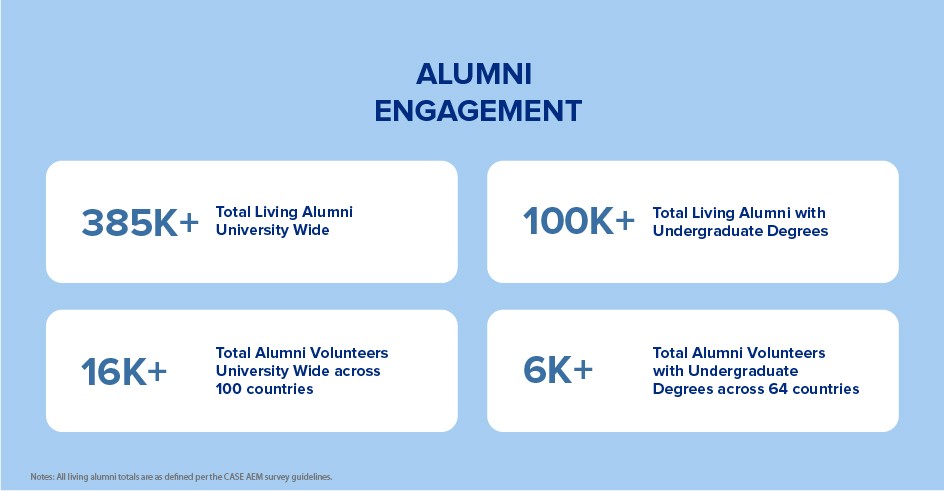
What Will the Two Data Sets Tell Me?
The Common Data Set consists of ten major sections. In some areas, where it is impossible to separate the Columbia College/Columbia Engineering experience from the Columbia General Studies experience, the data are the same. In other areas, including enrollment and admissions, the schools are distinct and key differentiating features are noted below, in an annotated guide to the ten Common Data Set categories.
Columbia undergraduates have access to the same classes, faculty, clubs, and university-wide services such as Columbia Health.
In a nutshell, whereas the student profile varies between Columbia General Studies and Columbia College/Columbia Engineering, the student experience is often similar. Style of housing (Section F: Student Life) may differ depending on the undergraduate school, as will need-based and non-need based financial aid (Section H. Financial Aid). But undergraduates have access to the same classes, faculty, clubs, and university-wide services, such as Columbia Health.
The overlap in undergraduates from the three schools begins in the classroom and extends to a wide range of extracurricular activities. Take a look at the Columbia Space Initiative, a student technology club founded in 2015. Members, including those in leadership positions, hail from Columbia College, Columbia Engineering, Columbia General Studies, and Barnard College. The same is true of the Columbia Venture Partners, the Varsity Show, and the Formula Racing club. Engineers Without Borders is open to all students at Columbia and Barnard and encourages a multidisciplinary approach to sustainable and community-driven development projects in Morocco, Uganda, and Ghana. Indeed, nearly all of the more than 500 student clubs and organizations are open to all undergraduate students.
Meet Some of Our Many Exceptional Undergraduates
A Deeper Dive Into the Ten CDS Sections
Additional context and explanation are provided below for each CDS category. The full CDS submissions for Columbia College and Columbia Engineering, and for Columbia General Studies, are available on this website.
This section provides basic information about the address, classification of the undergraduate institution, the academic calendar, and degrees offered. Of note, all three undergraduate schools—Columbia College, Columbia Engineering, and Columbia General Studies—are located in close proximity on Columbia University’s Morningside campus.
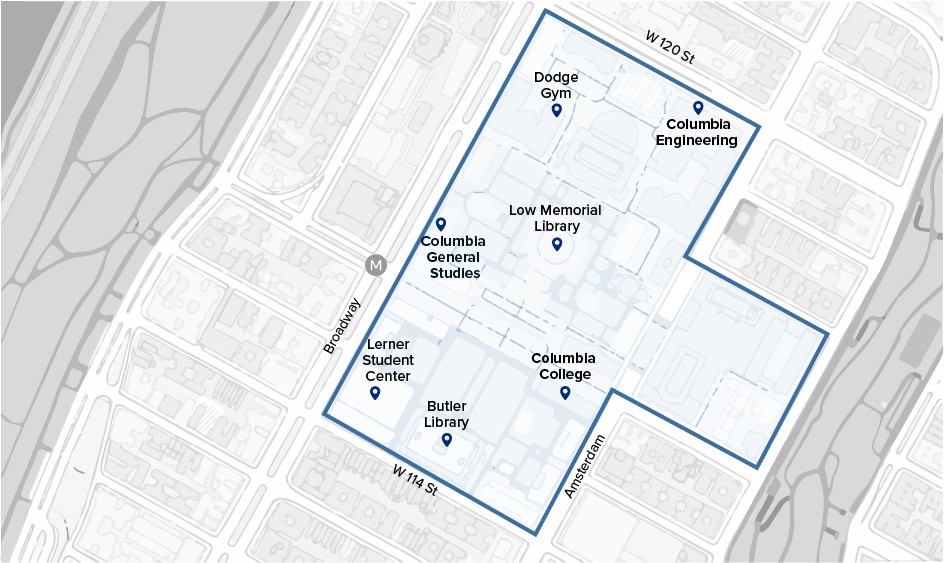
The administrative offices of Columbia College, Columbia Engineering, and Columbia General Studies are all on the Morningside campus, where students in all three schools take classes together.
This section highlights important data, such as the number of students and how they identify, the number of degrees awarded, as well as graduation and retention rates. When comparing the different categories, it is important to note that Columbia General Studies students can attend school part time or pause enrollment at any time to accommodate their professional working schedules or other commitments.
Dual Degree Programs
Columbia General Studies and Columbia Engineering have established partnerships, both domestically and internationally, that allow unique cohorts of students to enroll in joint and dual-degree programs.
Columbia Engineering offers the 3-2 Combined Plan Program, which provides undergraduate students from Columbia College, Columbia General Studies, and affiliated institutions the opportunity to earn both a bachelor of arts degree from their undergraduate school and a bachelor of science degree from Columbia Engineering in five years.
Columbia College also offers the 4-1 program, which allows Columbia Engineering students to take an additional year of study at Columbia College and receive a bachelor of arts degree from Columbia College in addition to a bachelor of science degree from Columbia Engineering at the end of five years.
Meet Two of Our Exceptional Dual Degree Columbia Engineering Students
- Tes DeJaeger: Combined Plan Student Chooses Best of Both Worlds
- Charlie Renner: Expanding Educational Interests Through the Combined Plan
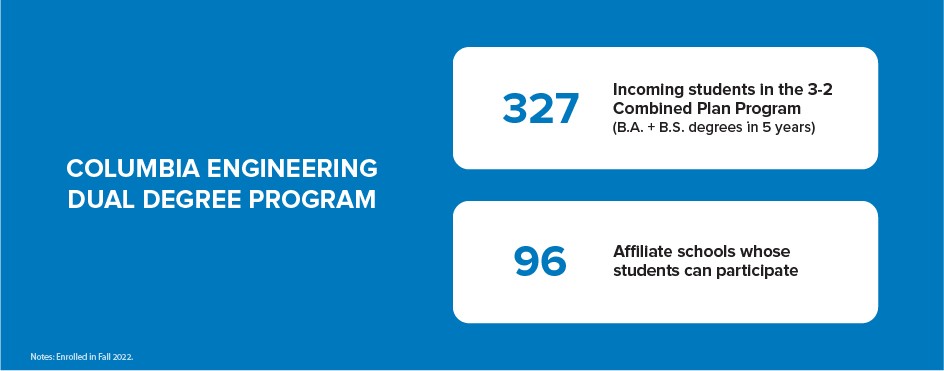
A defining characteristic of the Columbia General Studies undergraduate community is the array of innovative dual and joint degree programs open to all students, including those applying directly from high school, in partnership with Sciences Po, Trinity College Dublin, Tel Aviv University, City University of Hong Kong, and List College of the Jewish Theological Seminary. These programs offer students an interdisciplinary approach to a liberal arts education and the opportunity to pursue a nontraditional, undergraduate experience. Students in these programs immerse themselves in two distinct academic, social, and cultural environments while earning two undergraduate degrees in four years.
Meet Two of Our Exceptional Dual and Joint Degree Columbia GS Students
- Joseph Aimard (GS‘24): Trinity Dual BA Student Helms Innovative Project to Illuminate Migrant Experiences
- Hayat Aljowaily (GS‘20): Sciences Po Dual BA Alumna Works to Bring Diversity and Authenticity to Popular Cinema
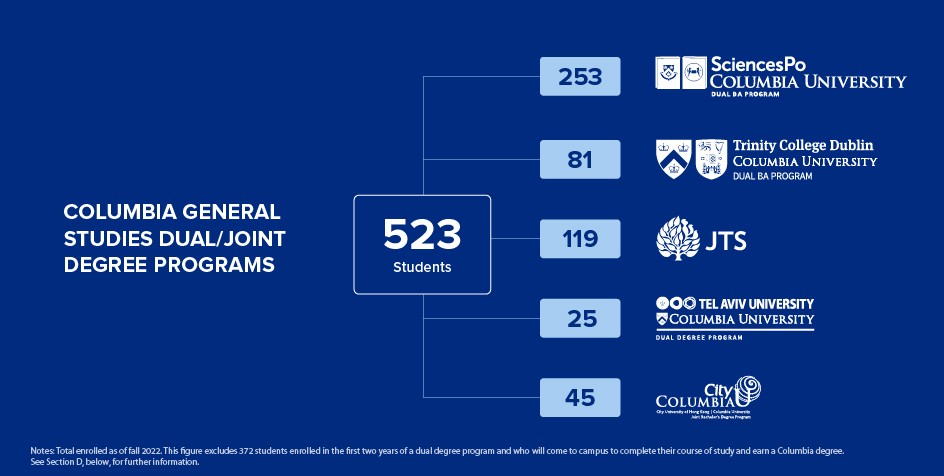
It is important to note that undergraduate enrollment numbers and percentages listed in the CDS and the graphic above do not include over 372 students enrolled in the first two years of one of the international dual degree programs (that is, those enrolled beginning in the fall of 2021 and 2022), though their course of study will bring them to Columbia’s campus and they will graduate with a Columbia degree. There are 232 premedical prehealth certificate-seeking students enrolled in Columbia General Studies' Postbaccalaureate Premedical Program – in the CDS, these students are captured as graduate students as they have previously earned a bachelor’s degree.
While Columbia College and Columbia Engineering have a certain number of transfer students, transfer students are at the very core of Columbia General Studies, with many arriving as community college graduates or veterans, a topic further explored in Section D.
Section C addresses the number of first-time, full-time student applicants (admitted, enrolled, and wait-listed) as well as the schools’ admission requirements. For the fall of 2022, the university enrolled a total of 1,494 first-time, full-time undergraduates – 1,463 to Columbia College and Columbia Engineering, 31 to Columbia General Studies.
Incoming Columbia College and Columbia Engineering students are primarily first-time first-year students, meaning they enter Columbia directly from high school and adhere to similar traditional admission requirements (although accepted students may defer for up to two years). Except for the dual and joint degree programs described in Section B, Columbia General Studies students are typically eligible for admission if they have taken a break of a year or more in their educational paths.
Because applicants to Columbia General Studies have such diverse backgrounds, the Columbia GS admissions process does not use the Common Application, opting instead for a fully holistic approach that takes into account not only an applicant’s level of academic preparation and qualifications, but also their unique life experiences, both of which demonstrate their ability to succeed at Columbia.
For applicants to Columbia College and Columbia Engineering, standardized testing remains an optional component of a student’s application. Based on an internal study encompassing multiple years of performance data, the university found that test-optional admissions—which Columbia College and Columbia Engineering provisionally introduced in 2020-2021 due to the COVID-19 pandemic—did not lead to a diminishment of the academic performance of admitted classes or the academic success of enrolled students. The application and its requirements are designed to afford the greatest possible opportunity and flexibility for students to represent themselves fully and showcase their academic talents, interests, and goals.
This section focuses on the number of transfer students accepted as well as transfer requirements, deadlines, and credit policies. The CDS defines this category as “students who applied, were admitted, and enrolled as degree-seeking transfer students.” Furthermore, the CDS directs institutions to include any student entering the institution for the first time who has previously attended a different postsecondary institution at the same level (e.g., undergraduate).
The number of students who transfer from another college or university varies among undergraduate programs. Traditional transfer students (meaning students who started as first-time, first-year students at another institution and will finish at Columbia without a break in their studies) may apply to Columbia College and Columbia Engineering while currently enrolled in another two- or four-year institution. Of the total of 282 transfer students reported in the CDS for Columbia College and Columbia Engineering, Columbia College enrolled 111 traditional transfer students and Columbia Engineering enrolled 37 traditional transfer students.
Columbia Engineering enrolled an additional 134 students from affiliate partner institutions as part of the 3-2 Combined Plan Program in Engineering. In this 3-2 Combined Plan program, students earn a Bachelor of Arts degree from their undergraduate affiliate institution and a Bachelor of Science degree from Columbia Engineering in five years. While these students are not traditional transfer students, they are included as transfer students in the CDS per the instructions indicating that all students who previously attended another undergraduate institution should be counted in this section. Of note, students enrolled in the 3-2 program who earn a Bachelor of Arts from Columbia College and a Bachelor of Science from Columbia Engineering are not included in this figure as students from the same institution are not counted as “transfers” per the CDS instructions.
For the fall of 2022, Columbia General Studies enrolled 401 transfer students, all of whom had taken a break at some point in their studies. As described in previous sections, Columbia General Studies attracts students from a wide range of nontraditional backgrounds, including those who seek to transfer college credit at various stages of their educational or professional paths, including community college students and veterans. Of the 401, transfer students, 231 previously attended community college and 59 were members of the military who joined the Columbia General Studies community having previously earned college credit at another institution. Indeed, this factor is one of the primary reasons why Columbia’s undergraduate profile is unique among its peers.
In addition to the 401 fall transfer students, Columbia General Studies also enrolled 154 spring transfer students. We did not report spring transfer students in our CDS because the CDS question only asks about fall enrollments.
Section E provides details on special study options and academic areas that are required for graduation. The information found here is generally similar for Columbia across all three undergraduate schools.
The Core Curriculum
What is particularly distinct about Columbia is its celebrated Core Curriculum—established more than a century ago at Columbia College. The Core introduces undergraduates to influential books and ideas in literature, philosophy, science, history, writing, art, and music. Its central purpose is to teach students how to think critically, challenge assumptions, and have open and probing discussions about complex issues. Such conversations push students to grapple with profound questions about the human experience that have engaged the brightest minds throughout recorded history.
Most of the classes are small and discussion-based. In the Core seminars, enrollments are capped at 22 or 24 students depending on the course. The exception is University Writing, which caps enrollment at 14 to ensure that students have the support needed to develop their capacity as independent academic readers and writers.
The small class sizes provide students with opportunities to develop intellectual relationships with faculty early on in their academic careers and to participate in a shared process of intellectual inquiry. In the Core, the pursuit of better questions is every bit as important as the pursuit of better answers. The skills and habits honed by the Core—careful observation, close analysis, effective argument, imaginative comparison, and respect for a variety of ideas—provide a rigorous preparation for life as an engaged citizen in today’s complex and changing world.
Requirements vary somewhat among the three undergraduate schools, and they also include foreign language and physical education components. The key courses—explained in further detail below—are Literature Humanities, Contemporary Civilization, University Writing, Art Humanities, Music Humanities, Global Core, and Frontiers of Science.
Students begin to engage in the Core Curriculum in their first year:
Columbia College undergraduates are required to take all seven Core courses, some of which span two semesters.
Columbia Engineering students must take either Literature Humanities, Contemporary Civilization, or Global Core and either Art Humanities or Music Humanities. Within the engineering program, all students take the Art of Engineering, a course focused on how science and math foster design solutions within an engineering context. In this popular course, students attend design lectures and work on real engineering projects. These skills are further developed as many students progress toward their senior year projects. Engineering students are also encouraged to participate in faculty research projects through the Student Research Program.
Columbia General Studies students are required to take Art Humanities and Music Humanities. They can meet all or a part of their literature/humanities, social science, and science Core requirements by taking Literature Humanities, Contemporary Civilization, and Frontiers of Science.
All undergraduates take University Writing.
Core Curriculum Classes
In Literature Humanities, students engage with seminal literary and philosophical texts that have shaped Western thought for nearly three millennia. The course encourages students to be critical readers of the recorded past and examine its continued significance in the present.
Through an exploration of historical and philosophical works of literature, Contemporary Civilization asks students to reflect on the kinds of political, social, moral, and religious communities that human beings construct for themselves and investigate the values that inform those communities.
University Writing teaches students to become more capable and independent writers, emphasizing habits of mind and skills that foster students’ capacities for critical analysis, argument, revision, collaboration, meta-cognition, and research.
Art Humanities provides an analytical study of a selection of influential monuments and artists that teaches students how to look at, think about, and engage in critical discussions of the visual arts.
Music Humanities examines the evolution of the Western musical imagination through the study of famous musical works and their historical and cultural contexts.
Courses in the Global Core ask students to engage with the variety of civilizations and the diversity of traditions that, along with the West, have formed the world and continue to shape it in the present. These classes typically explore the cultures of Africa, Asia, the Americas, and the Middle East in an historical context.
Frontiers of Science challenges students to think about the world around them and the ways in which science can illuminate questions about humanity and the natural world.
Academic Bulletins
Each undergraduate school’s academic bulletin contains a wealth of information about the educational opportunities and requirements that are unique to Columbia College, Columbia Engineering, and Columbia General Studies.
Columbia College
From their foundation in the Core, Columbia College students branch out into a broad array of academic disciplines represented by the more than 125 majors and concentrations offered across 58 departments within the Faculty of Arts and Sciences. Detailed information on these programs—from the humanities to natural sciences—can be found in the Columbia College Bulletin. Through their chosen program of study, students dive into Columbia’s rich tradition of scholarship and academic inquiry, with opportunities to participate in groundbreaking research and pursue co-curricular experiences on-campus and around the world that enhance their work in the classroom.
Columbia Engineering
The undergraduate programs at Columbia Engineering are both academically exciting and technically innovative, leading to a wide range of career paths for the educated citizen of the twenty-first century. This education begins with the Art of Engineering, which introduces fundamental concepts of engineering. While pursuing their own interests, undergraduates are encouraged to participate in a broad range of ongoing faculty research projects encompassed by the Student Research Program. In addition to in-depth exploration of engineering and applied science, Columbia Engineering undergraduates explore the humanities and social sciences with Columbia College students through intellectually challenging Core Curriculum courses providing students with a broad, intellectually disciplined, cultural perspective. School policy requires students to fulfill all general degree requirements as stated in the bulletin of their first year. Students declare their major during the first semester of their sophomore year with requirements for the major or minor in accordance with that year’s bulletin.
Columbia General Studies
Columbia General Studies students earn a Bachelor of Arts degree (BA), combining breadth of study in a range of subjects and disciplines, represented by the Core requirements, with specialization in a major field of study. Flexibility within the Core allows students to choose courses from several departments, thereby encouraging them to explore new areas of inquiry, develop their intellectual interests, and situate their knowledge within the age-old tradition of Western thought while reflecting critically about this tradition and its place in global history. In addition to the Core requirements and the major requirements, many students will meet part of the 124 points required for the bachelor's degree with elective courses that will broaden their knowledge base, provide an opportunity to acquire or improve certain skills, introduce them to a new field of inquiry, or give them access to a unique Columbia strength or resource.
Section F of the Common Data Set aims to capture “first-year” information, including housing on and off campus, fraternities and sororities, activities offered, and average age of students. Very few Columbia General Studies students are the equivalent of first-year, first-time students (Columbia General Studies does not categorize its students into traditional academic cohorts).
One major difference among the three schools is in housing. Columbia College and Columbia Engineering students live in residence halls on campus, with on-campus housing guaranteed for all four years, while most Columbia General Studies students–some of whom have families–live in apartments off campus (including apartments in Columbia Residential housing).
The three undergraduate schools share most co-curricular resources, including athletics and wellness. The vast majority of student clubs and organizations are open to all undergraduates, as well as to students from Columbia’s affiliate, Barnard College. All undergraduates receive health care through Columbia Health.
Columbia’s Center for Career Education also serves all three undergraduate schools, providing access to networking connections, experiential learning opportunities and jobs, comprehensive resources, and customized career counseling. The Center for Undergraduate Global Engagement supports academic and co-curricular opportunities for global learning and engagement among all undergraduates, including study abroad, international internships, service-learning, research, and global courses—both on campus and abroad. What’s more, the Columbia Alumni Association is a universal alumni community with clubs across the country and around the world.
This section highlights the full-time costs of tuition, required fees, and room and board. Each school has its own costs. For example, Columbia College and Columbia Engineering undergraduates are charged a flat rate for tuition, whereas Columbia General Studies students are charged by the credit. The university encourages a careful reading of each school’s costs of attendance and admissions guidelines on their respective websites.
Section H addresses financial aid, the number of enrolled students and average aid awarded (need and non-need based), financial aid filing deadlines, types of aid available, scholarships and grants available, and criteria for awarding institutional aid. For all three undergraduate schools, admissions are need-blind—that is, the applications of U.S. citizens and eligible non-citizens are evaluated without regard to financial need.
For Columbia College and Columbia Engineering, all financial aid is need-based. Through the generosity of our alumni and donors, the university is able to meet 100 percent of demonstrated financial need for all first-year and transfer students pursuing their first degree. With the goal of helping students in need graduate debt free, loans are not used to meet financial need and are not included in initial financial aid awards. Rather, aid is provided through university grants.
Columbia General Studies is committed to providing support for nontraditional students navigating their educational expenses. Although it does not yet have the endowment resources to meet full need, the School awarded nearly $37 million in financial aid to General Studies students for the 2022-2023 academic year, and continues to work toward increasing the amount of aid available. Students at Columbia General Studies may be eligible to receive scholarships, grants, loans, and work-study. Financial aid may come from Columbia General Studies, federal and state governments, or private sources. Columbia University is also a proud participant in the U.S. Department of Veterans Affairs Yellow Ribbon Program, with Columbia General Studies enrolling the majority. The scope of benefits provided by the Post-9/11 GI Bill® and the Yellow Ribbon Program makes it possible to cover 100% of tuition and fees for eligible veterans.
In 2021, we announced the Columbia Student Support Initiative, a university-wide plan to expand access and increase affordability by raising $1.4 billion by 2025.
Columbia encourages a careful reading of each school’s financial aid policies, which take into account each student’s personal situation.
I-1: Instructional Faculty
As directed in the CDS, we have reported 1,651 full-time instructional faculty members who provide instruction to undergraduate and graduate students at Columbia. This number does not include full-time medical faculty appointed at Columbia University Irving Medical Center. Of the 1,651 full-time faculty, 96% have a doctorate or terminal degree in their field according to CDS instructions.
Across all our professional schools, Arts & Science, Engineering, and the School of the Arts, Columbia has a total of 1,619 part-time faculty providing instruction with the large majority (62%) of them teaching solely graduate students enrolled in our professional schools. Columbia has 434 part-time faculty engaged in the instruction of a class with at least one undergraduate student enrolled. The distribution of part-time faculty varies across different academic disciplines and schools, with over 350 (23% of total) part-time faculty providing instruction for the School of Professional Studies and over 800 (50%) providing instruction in graduate level courses in academic areas that include Social Work, Arts, Law, Journalism, International and Public Affairs, Architecture, and Business.
I-2: Student to Faculty Ratio
Columbia’s student to faculty ratio is 6 to 1 and has remained consistent for many years. In calculating the student to faculty ratio, we follow the CDS instructions to report the Fall 2022 ratio of full-time equivalent students (full-time plus 1/3 part time) to full-time equivalent instructional faculty (full-time plus 1/3 part-time). As directed, we exclude faculty and students in stand-alone graduate or professional programs.
I-3: Class Size
Columbia students across all three undergraduate schools have a wide variety of courses to choose from, close to 2,000 in each of the fall and spring semesters. Undergraduates can also take courses at our affiliate, Barnard College and, after fulfilling all pre-requisites and obtaining appropriate permissions, advanced courses at Columbia's graduate schools.
Columbia undergraduates engage in several types of class settings throughout their time on campus, including lectures, seminars, labs, and language courses. Columbia has a pedagogical commitment to small class sizes to provide highly interactive engagement among undergraduate students and faculty and support a diversity of perspectives in the classroom.
Undergraduate Course Types
Lecture courses typically meet twice a week for 1 hour and 15 minutes each session. While lectures may range in size, many of the undergraduate lectures also have a required discussion section that meets once a week in small group settings. These small sections typically have 15-17 students in each small group and meet in departmental and university classrooms.
Seminars are small and intensive group courses that most departmental majors require for undergraduates enrolled in Columbia College and Columbia General Studies. Although seminars typically have between 20 and 25 students, many seminars have an enrollment of 15 students or fewer. The undergraduate requirement to participate in seminars may vary by department but, in addition to the Core Curriculum, Columbia College and Columbia General Studies undergraduates are required to participate in at least one seminar course before graduation to ensure that all students have the opportunity for small group engagement with faculty. Engineering students do not have a seminar requirement (outside of the Core) but many Engineering students participate in seminars with their Columbia College and Columbia General Studies peers.
Many of the undergraduate courses in the Natural Sciences and in Engineering require participation in smaller laboratory sections. In Arts and Sciences courses, the laboratory sections are often no larger than 20 students or fewer and typically have enrollments of 12-15. Laboratory sections in Columbia Engineering are typically capped at 24.
All undergraduates in Columbia College and Columbia General Studies are required to complete four semesters of a language unless they test out. Language sections by definition are very small classes, often no larger than 12-15 students, and form a substantial part of the curriculum for Columbia College and Columbia General Studies undergraduates. Undergraduate students in Columbia Engineering do not have a language requirement.
Undergraduate students across all three undergraduate schools also have opportunities to engage in independent studies and research experiences with faculty members who work intensively with their students to supervise a course of study or research project.
Core Curriculum
In Columbia's 100+ year old Core Curriculum, undergraduate students in Columbia College, Columbia General Studies, and Columbia Engineering are taught in small seminars to provide a setting that encourages active engagement and discussion as well as the development of strong relationships with their peers and teachers. All Columbia College students are required to take the full complement of the Core all taught as seminars; this includes Literature Humanities, Frontiers of Sciences, University Writing, Contemporary Civilization, Art Humanities, and Music Humanities. In the Core seminars, enrollments are capped at 22 or 24 students, depending on the course. The exception is University Writing which caps enrollment at 14 to ensure that students have the support needed to develop their capacity as independent academic readers and writers. Students in Columbia College and Columbia General Studies are also required to take two courses toward the Global Core requirement, which are required to be either small seminar courses or lecture courses with a small discussion section component.
Class Size Data
In completing the Common Data Set, Columbia has strictly applied the methodology for tracking and reporting class size. Our commitment to small class sizes that allow for close relationships between students and faculty and supports the exchange of a wide range of perspectives and ideas remains unchanged. As reflected in the CDS data, 77% of our undergraduate classes have class enrollments under 30 students and 73% of classes have under 25 students. More than half (58%) of all classes have enrollments under 20.
Finally, small course sections, such as laboratory, recitation, and discussion sections, as described above, are not all reported in our CDS, but are a critical component of a Columbia undergraduate education and are often managed at the departmental level. Students in all three undergraduate schools take small course sections—it is a foundational component of their education and speaks to the curriculum’s academic rigor and standards of excellence.
To see the list of degrees conferred by disciplinary areas at Columbia, visit Section J on the CDS.
Our Commitment
The university realizes that applying to college is an opportunity to reflect on who you are and what you are seeking in your next educational step. However, the college application process can also be confusing at times. Columbia is committed to sharing the most accurate information available to help guide you through the process. We also encourage you to contact the appropriate admissions office to address further questions.
For students or parents interested in applying, please visit:
The information provided is accurate and complete to the best of our knowledge, as derived from available records relied on by the University.


